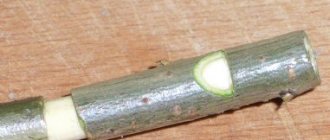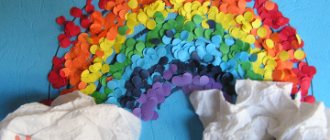You can make an unusual and stylish piggy bank with your own hands from an ordinary tin can with a lid for storing bulk products. For this, special knowledge or skills are completely unnecessary, the main thing is that your hands are at least somewhat skillful. We will decorate a tin can with strips of paper towels, creating a relief of randomly laid fabric, followed by painting with acrylic paints, decorating with mother-of-pearl semi-beads, decorative chains and small golden locks.
To make a piggy bank from a tin can we will need:
- tin can of any size and shape
- roll of paper towels
- PVA glue about 200 gr.
- acrylic paints black matte
- acrylic paints gold
- semi beads
- decorative chain
- small locks
- coins of different denominations
- glue Titan
- hard and soft wide brushes
- black beads (a little)
First you need to cut strips of paper towels about 4-5 cm wide. Dilute PVA glue with water 1:1 in a container with a wide neck. It is more convenient to “work” with a rectangular or square tin can; in the process you will understand “why”.
How to make a piggy bank with your own hands from a tin can
Dip the prepared paper towel strips one by one into the diluted glue. When removing the workpiece, you need to squeeze it slightly, passing it between two fingers. You should act carefully, without pressure, to avoid tearing the paper. The strip should only be saturated with the adhesive mass, but not soften in it. The resulting strip must be carefully placed diagonally on the tin, creating random folds, like on fabric. Thus, it is necessary to lay the strips on one side of the jar and leave the craft until the glue dries. The opposite side is covered in a similar way. In total, you need to make two or three layers of paper towels to make the piggy bank look solid and stylish.
This is what the workpiece should look like:
A completely dried piece can be decorated. First you need to paint it in the base color, for which we take matte black.
Before painting, acrylic paint must be diluted with water in the proportion of 1 part paint: 2 parts water. It is recommended to use a wide soft brush. While painting, try not to miss any folds and fill every millimeter of the future piggy bank with paint.
Now the paint should dry completely. It will take about 5 hours. In the meantime, you can start decorating the lid of the piggy bank.
Decoration of the piggy bank lid with coins, semi-beads and seed beads
First of all, you need to make a bill and coin receiver from the lid. To do this, simply cut a rectangular hole with a knife. To equip the piggy bank with locks, we cut out a round hole on the sides of the lid and on the piggy bank itself.
Now let's glue the coins using Titan glue. We apply glue to the coins and place them on the surface of the lid in a random order, in a slightly disorderly manner. We decorate the hole for the money with beads, gluing them in the same way as coins. We “fill” the gaps between the coins with black beads.
The penultimate stage of making a piggy bank with your own hands from a tin can is applying gold acrylic paint. To do this you will need a hard wide brush.
There is no need to dilute the gold paint!
The gold decor is applied to the surface of the folds of the piggy bank's trim with light brush strokes, lightly touched with paint. When dry, the gold decor on a black background creates the effect of old red gold, glitters beautifully in artificial light, and looks expensive!
If you take a small piggy bank with your own hands
not only as a children's toy, not only as some kind of temporary means of saving, but as a reason to make an interesting decorative element for the interior, then the task changes a little. Now it is not enough to cut a hole in the box for coins and bills, you also need to decorate this box with dignity, no worse than. It is about interesting ideas for organizing a home bank that we will talk below.
Textile decor
Required materials and tools:
- glass jar with lid;
- fabric and ribbons for decoration;
- glue gun;
- scissors and a sharp knife.
Step 1. Cover the jar with cloth; use a gun for this.
You should not choose very thin or light-colored material as finishing, as glue may be visible on it.
Step 2. Using a knife, make a rectangular hole in the lid for coins. Then cover the lid with the same fabric as the jar. Make a cut in the center of the jar and carefully wrap the material inside, securing the edges with glue.
Step 3. Glue decorative tape along the edges of the lid.
That's it, your piggy bank is ready! You can add details to your liking - rhinestones, sequins, beads. Or place a photo on the accessory, so you will combine two decorative items in one - a piggy bank and a frame.
Video about making a piggy bank with textile decor:
OPERATING INSTRUCTIONS
Before starting work, you need to calibrate it for your coin, this is done as follows. The Arduino has a reset button, and next to it there is our calibration button. We press the calibration button, and then reboot the Arduino, without releasing the button. The service button will appear on the display; hold the button for 3 seconds. Then the message memory cleared will appear. This procedure resets the number of coins that were thrown into the piggy bank. Let go, the calibration process starts. Now you need to throw coins into the piggy bank with the price indicated on the display. The system finds the maximum signal value from the sensor for each coin and writes it into memory; all settings are saved even after a reboot. That's it, the piggy bank returns to normal mode.
Let's count how much change I had in my wallet. Now the system is in deep sleep and has eerie digital dreams. As soon as I insert a coin, the contacts at the entrance to the slot close, and the Arduino wakes up and turns on the display and sensor, and begins to wait for the coin. If you stop throwing coins, the display will go dark and the Arduino will fall asleep again. And now I’ll show you another interesting function: insert a coin and hold it for a few seconds, that is, we close the contacts. And the display shows the price of the coin in the first line, and the number of these coins in the second line, that is, we know how many coins of each type are in the piggy bank at the moment. And then we fall asleep again.
Piggy bank with a pattern
This master class requires the following materials and tools:
- glass jar with lid;
- white acrylic paint;
- PVA glue;
- sponge;
- file;
- spray bottle with water;
- sharp knife;
- dry brush;
- a napkin with your favorite pattern;
- acrylic lacquer;
- sandpaper M40 (zero grade).
Related article: Master class on a vase of pine cones step by step with photos and videos
Step 1. Before you begin, the jar needs to be prepared. If necessary, remove the label, get rid of traces of glue, and degrease with alcohol.
Step 2. Carefully make a hole in the lid for coins.
Step 3. Dip a sponge into acrylic paint and, using gentle movements, apply it evenly to the surface of the lid and jar. The coating should be as thin as possible. After this, let the future piggy bank dry completely and apply paint in two more layers.
Step 4. Carefully tear off the part with the design you like from the napkin. In this case, you should not resort to scissors, since the torn edge will be less likely to be replaced on the finished product. Then very carefully peel off the top layer of the napkin where the design is applied. It is important to choose an image that is proportional to your jar. Please note that after subsequent manipulations the napkin will increase in size.
Step 5. Dilute PVA glue with water in a 1:1 ratio. Place the napkin face down on the file. Spray thoroughly with water using a spray bottle and apply diluted PVA.
Step 6. This is the most important step in creating a piggy bank. Carefully attach the file with a napkin to the outside of the jar, pressing lightly with your fingers. Then carefully delete the file.
Step 7. Using a dry brush, go over the surface of the napkin. Perform this manipulation from the center to the edges. Gently smooth out any wrinkles or air bubbles.
Step 8: Leave the jar to dry completely. Any remaining imperfections (bumps or creases) can be carefully rubbed out using soft sandpaper.
Step 9. To fix the picture, you need to cover the jar with acrylic varnish. It is better to do this in 2-3 layers. It’s just important to let the jar dry after applying each one.
Advice! To prevent coins from damaging the bottom of the jar, place foam rubber or several layers of soft cloth.
Files
Permalink
| Type | Name | Latest commit message | Commit time |
| Failed to load latest commit information. | |||
| money_box_counter | upd | Sep 15, 2017 | |
| money_box_counter_voltmeter | |||
| Libraries | |||
| .gitattributes | |||
| .gitignore | |||
| README.md | |||
| scheme1.jpg | |||
| scheme2.jpg | |||
Piggy bank with coin counter
Electronic coin recognizer (by size) for a piggy bank with a total counter and statistics for each type of coin. Functional:
- Recognize the size of coins with high accuracy and link it to the value of each coin
- Calculating the total amount of coins in a piggy bank
- Statistics on the number of coins of each type
- All settings are saved in non-volatile memory and are not reset when powered up
- The accumulated amount is also stored in non-volatile memory and is not afraid of power failures
- Deep power saving mode: in sleep mode, 0.07 mA is consumed, in a circuit without a converter 0.02 mA
- Supports any number of coins of different sizes
- Automatic calibration of coin types
- Reset accumulated quantity
- Details in the video:
- Libraries - libraries for display and other things, copy to C:Program Files (x86)Arduinolibraries (Windows x64) C:Program FilesArduinolibraries (Windows x86)
- money_box_counter - firmware for Arduino, open the file in the folder in the Arduino IDE (read FAQ)
USB power circuit
Battery power supply via mosfet
Materials and components
If the product is out of stock, then almost everything listed below can be found here https://alexgyver.ru/arduino_shop/ or here https://alexgyver.ru/electronics/
- Arduino NANO 328p – search
- https://ali.ski/tI7blh
- https://ali.ski/O4yTxb
- https://ali.ski/6_rFIS
- https://ali.ski/gb92E-
- Display 1602
- https://ali.ski/2VMIU
- https://ali.ski/4fLT6w
- Sensor search
- https://ali.ski/5zgKju
- Increase https://ali.ski/NzWdL3
- Buttons and more https://alexgyver.ru/electronics/
- Mosfets (list of suitable ones: IRF3704ZPBF, IRLB8743PBF, IRL2203NPBF, IRLB8748PBF, IRF3704PBF, IRL8113PBF, IRL3803PBF, IRLB3813PBF, IRL3502PBF, IRL2505PBF, IRF3711PBF, IRL3713PBF, IRF3709ZPBF, AUIRL3705N, IRLB3034PBF, IRF3711ZPBF)
- Separate phototransistors: L-7113P3C, L-53P3C
- Individual LEDs: L-7113F3C, L-53F3C
- Batteries https://alexgyver.ru/18650/
- Charging and protection module https://ali.ski/pspbG
You will most likely find it useful
Setup and use
- Firmware download - ultra detailed article on getting started with Arduino
- Press and hold the calibration button, then power up/reboot the Arduino
- If you release the calibration button, the system will enter calibration mode
- If you hold for another 3 seconds - memory clearing mode (resetting the number of coins)
- After calibration is completed, the system will automatically return to normal operation.
Settings in code
Q: How to download from this fucking site? A: On the main page of the project (where you read this text) at the top right there is a green button Clone or download , click it, there will be Download ZIP
Q: I downloaded some kind of .zip file, where does it go now? A: This is an archive. You can open it using standard Windows tools, but I think everyone has WinRAR installed on their computer, the archive needs to be right-clicked and extracted.
Q: I'm completely new! What should I do with Arduino, where can I get all the programs? A: Read and watch the video https://alexgyver.ru/arduino-first/
Q: The computer does not react in any way to connecting the Arduino! A: Perhaps you have a USB charging cable, but you just need a data cable through which you can transfer data
Q: Error! The sketch doesn't compile! A: The path to the sketch should not contain Cyrillic. Put it in the root of the disk.
Q: How much does it cost? A: I don't sell anything.
Questions about this project
Q: Nothing is shown on the display! A: Turn the contrast adjustment on the back of the display board
Superhero accessory
This option is suitable for those who have a small fan of the world of comics living at home. And creating such an accessory will be an excellent way to have fun and useful leisure time.
Related article: Beaded cactus: weaving pattern and cactus flower master class with photos and videos
Required materials and tools:
- glass jar with lid;
- spray paint;
- colored paper or template with a superhero logo;
- PVA glue or glue gun;
- acrylic lacquer;
- scissors and knife.
Step 1: Prepare the jar. Wash thoroughly, remove label and glue, degrease with alcohol.
Step 2: Use a sharp knife to make a coin hole in the lid.
Step 3: Apply spray paint to the lid and jar. Paint in several layers, each time letting the future piggy bank dry thoroughly. The color of the product depends on which superhero the child chooses. For Batman's piggy bank, black paint is suitable, for Superman - blue.
Step 4. Cut out a superhero emblem from colored paper or pre-print the template on a color printer, cut and glue.
Step 5. Cover the finished product with acrylic varnish in two layers, each time letting the piggy bank dry thoroughly.
Superhero emblem templates.
Turtle
You will need: 1.5-2 liter green plastic bottle, moisture-absorbing wipes (urethane foam), scissors, thick needle, thick threads, button, black pen.
Master Class
- Cut off the bottom of the bottle, then trace it on a napkin (urethane foam).
- Draw the head, 4 legs and tail of the turtle.
- Cut out the workpiece.
- Sew the plastic shell to the turtle's body, as shown in the photo instructions.
- Decorate the center of the shell with a button.
- Draw the turtle's face and claws.
- Cut a hole for coins.
- It is worth noting that this turtle swims remarkably well!
DIAGRAMS, PRINTED BOARDS
USB power circuit
Battery power supply via mosfet
Any container where you can put coins or paper bills is suitable for a piggy bank. The money vault should not be opened so that part of the savings cannot be taken out from there. You can buy it in a store or make it yourself, and the cost of creating it can be minimal. Before making a craft, you need to solve the questions: what materials will it be made from and how to make a piggy bank with your own hands.
Any container where you can put coins or paper bills is suitable for a piggy bank. The money vault should not be opened so that part of the savings cannot be taken out from there. You can buy it in a store or make it yourself, and the cost of creating it can be minimal. Before making a craft, you need to solve the questions: what materials will it be made from and how to make a piggy bank with your own hands.








